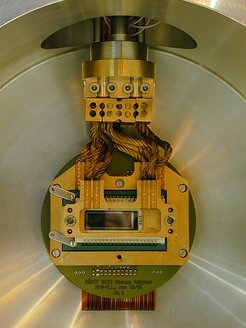CAST
The CERN Axion Solar Telescope (CAST) is an experiment to search for hypothetical particles called "axions". In the presence of a magnetic field the axion would be transformed with very low probability into a photon and vice versa. Therefore it is to be expected that axions are produced in the core of the sun and detectable at earth by conversion into photons with the help of a strong magnetic field.

A ten meter long magnet equipped with a magnetic field intensity of 9 T and a 14 cm2 opening follows the direction of the sun. The major challenges in such an experiment are the small amplitudes of the expected signal and the suppression of background due to other “normal” processes as for example from radioactivity and cosmic radiation. By introducing a focusing mirror telescope and a pnCCD in its focusing plane, the sensitive detector area and consequently the background has been reduced by a factor of 200. Furthermore the excellent spectral resolution of the pnCCD allowed the identification and rejection of individual radioactive background lines.
The experiment has provided upper limits for the axion-photon-conversion probability which is a factor of 10,000 times lower than it was available in previous experiments and it is the first time that the limit is lower than those derived indirectly from astrophysical considerations. In order to extend the axion mass range sensitivity to higher value, measurements are being performed in an atmosphere of 4He and 3He. In consequence the experiment is scheduled to be conducted at least until 2008 or later.
References:
L. Strueder, et al.,“The European Photon Imaging Camera on XMM-Newton: The pn-ccd camera,” Astron. Astrophys. 365,pp. L18–L26, Jan. 2001.
G. Lutz, et al., “An application of space technology to the terrestrial search for axions: The X-ray mirrortelescope at CAST,” Nuclear Instruments and Methods in Physics Research A 518, pp. 201–206, Feb. 2004.
